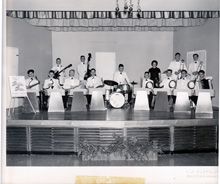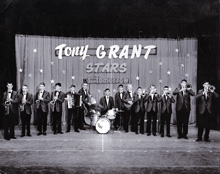The Mello MenThe history of the Mello Men, a dance band, thanks to Randolph Fillmore (with assistance from Paul Cridler). --------------------------------------------- In the fall of 1961, the Baltimore Sun ran an ad that called for musicians over the age of 14 who were interested in participating in a youth dance band to report on a Wednesday evening to a Methodist church in the Govans section of Baltimore near York Road and Belvedere Ave. And so started a dance band directed by Andy Messineo, a Baltimore native who played alto sax and clarinet and served in the U.S. Navy in World War II playing in the Navy dance band stationed at the Panama Canal Zone. In 1960, Andy had directed a previously no name dance band with young players. The band, sponsored by the Govans Optimist Club, seemed to go nowhere, so he placed the ad seeking new players. The band also changed its rehearsal venue to the church. From the no name band, Hal Eisenberg (alto), Eddie Anderson (alto), Paul Cridler (trumpet), Buck Clayton (trumpet) and Chip Costa (trombone) and Lyn Summerall (trombone) made the move and a new band formed around them in the fall of 1961 following auditions brought about by the ad. The auditions for the band that was to become the Mello Men saw many players audition. I was selected for the trumpet section. Most of the musicians at the start were 14-17 years old and the Govans Optimist Club continued to sponsor the band. After the auditions, the rhythm section included Bob Wyatt on drums, Rick Prowell on bass, Ron Eaton on guitar, Mike Schenk accordion, and Carolyn Cridler on piano. Costa and Summerall played trombone, Paul Cridler and I played trumpet and Anderson and Eisenberg both played alto. Doug Carrick played tenor. The band was originally named the “Blue Diamonds.” Perhaps the first time the band played in public was under that name and in February 1962 at Dundalk High School in a battle of the bands called “This Could Be The Start of Something Big” organized, in part, by Rick Prowell, who was a student at the school. At that event, the Blue Diamonds were a dance band playing music from the 1930s and 1940s while the other bands were traditional rock ‘n roll soul bands from the Dundalk, Maryland area. Clearly, the music played by the Blue Diamonds was not popularly competitive with that played by the very good bands at the event. However the gig became notable for the musicians we acquired who came to play with the band that a short time later became the Mello Men. After that event we added Hal Hagy on tenor sax, who was playing with another band at the event. Soon thereafter, for lack of paying gigs, the band decided, with strong parental assistance from Jack Cridler, Jack Anderson, Lynwood Summerall, Sr. and Doris Fillmore, to throw a dance at Overlea Hall. The band needed some visibility and also to make some money. The dance was successful as enough tickets were sold to pay for the hall and with what was left each player made $8. We also landed a few offers to play at local dances. People in our parents’ generation liked our renditions of the big band music they grew up with - from Tommy Dorsey to Glenn Miller - and we began playing dances at American Legion halls and at other dance events and venues held by a variety of organizations. The band’s regular personnel by 1962 were : saxes Rich Jones, Ed Anderson, Hal Hagy, Doug Carrick and Dave Hipsley (baritone); trumpets, Randy Fillmore, Paul Cridler and Richard Lederman; trombones, Lynn Summerall, Dan Trinter and Ken Brown; rhythm, Bob Wyatt, drums, Rick Prowell, bass, Ron Eaton, guitar, Carolyn Cridler, piano and Mike Schenk, accordion. Richard Lake started playing piano and arranging in 1963 after Carolyn Cridler went off to college. Two notable events marked the history of the Mello Men. The first was the trip to Atlantic City, New Jersey in the summer of 1963 to perform on the Steel Pier for the Tony Grant “Stars of Tomorrow” show. The second notable event was the making of the recording in November, 1963. The week at Atlantic City was carried out with high notes and low notes. The band performed two shows per day and went crazy at night partying, staying up and out all night, until Andy and the parental chaperones instituted a curfew. The lowest note was when Andy suffered a heart attack and was hospitalized. Andy recovered, but we left Atlantic City with him still hospitalized. He was in his forties and this was his second heart attack. The record was made in or around the 17th of November 1963 at a recording studio and radio station on Cold Spring Lane off of Loch Raven Blvd. The engineer was Lloyd Garrison. Once Andy reviewed the tapes and selected which tunes would be included, the tapes were sent off to be pressed into a 10 inch, 33 1/3 LP. The arrival of the finished product was delayed by the assassination of President Kennedy on November 22 as the nation shut down for three days. Copies of the record are extant and many have turned them into CDs. Another fortuitous turn was the band’s linking up with Lee Case, a DJ on WCBM radio who held “Coke Hops” sponsored by Coca-Cola. These were events where Case took local bands, even a dance band, to area schools and teen centers. The Mello Men received great publicity and some jobs from the Coke Hop appearances. That year also saw the band playing less at dances and teen centers and more often at country clubs in the greater Baltimore area. Prior to the Atlantic City trip, while playing at Sparrows Point Country Club, we were invited to come listen to the Glenn Miller band under the direction of Ray McKinley when they played at the country club. We later ran into them while we were playing in Atlantic City. They were playing in the Ball Room and we were on the Tony Grant Show. One later job we played at Sparrows Point Country Club included playing on a large raft in the middle of the swimming pool. The band also played concerts in the enlisted club at Fort Meade, Maryland. Because we played those concerts, the Army invited us to come hear Duke Ellington in concert at the same venue. The Army sent a bus up to Baltimore to collect us and many of us remember fondly mixing freely with not only the Ellington band members during their breaks, but also with Ellington himself. By late 1963 Jule Prince had begun playing piano and Lee Shauk joined as male vocalist. Wayne Phillips became the regular drummer. There were also many substitutes as well as short-term and part-time players, such as Charley Boynton, Ed Jenkins, Mike Burns, Jack Von Behren, and Don Lehnhoff, all of whom added to the quality of the band when periodically called upon or during their shorter stints with band. By 1964 new players included Paul Sigmond, drums, Barbara Ballard, vocals, Bill Yakitis, alto, Fred Woerner, tenor, Art Volpe, trumpet and Jack Von Behren, bass. By late 1965, most of the original band members, and many who came in 1964, were graduating or had graduated from high school and were heading to either college or into the military. Most of us had aged-out of the band that really only had three years of existence as the original Mello Men. The band did continue for several years after 1965 until it disbanded formally and Andy gave the music to Calvert Hall High School’s music department in the early 1970s. Andy Messineo died of a heart attack in 1976. He was 53. The Mello Men held a reunion in 1996 and, in 2002, participated in the second Baltimore Jam, a performance that set the stage for the tradition of having a big band at subsequent Jams. Too many of the original band members (and the parents who helped us) have passed on. The Mello Men who have died are listed on this website’s In Memory page. In many ways, the Mello Men helped launch or positively affected the music careers of Dan Trinter, who has played trombone professionally in Las Vegas since 1966, Bob Wyatt who has played professionally in Brazil since the early 1970s, and Richard Lake, PhD, composer and music director. Bill Yakitis, Paul Cridler, Charlie Phillips and Barbara Ballard went on to become school music teachers. Many of the Mello Men continue to be active players in local bands and in various music groups stretching from Maine to California, and Minnesota to Florida. We all benefitted from the love and guidance we received from Andy Messineo. Many, if not most of us, are in communication to this day, and this website has helped us all stay in touch.
|
SAX: Hal Hagy, Ed Anderson, Rich Jones, Doug Carrick SAX: Doug Carrick, Dave Hipsley, Ed Anderson, Hal Hagy 1963 Recording |
|---|
About Us | Contact Us |



